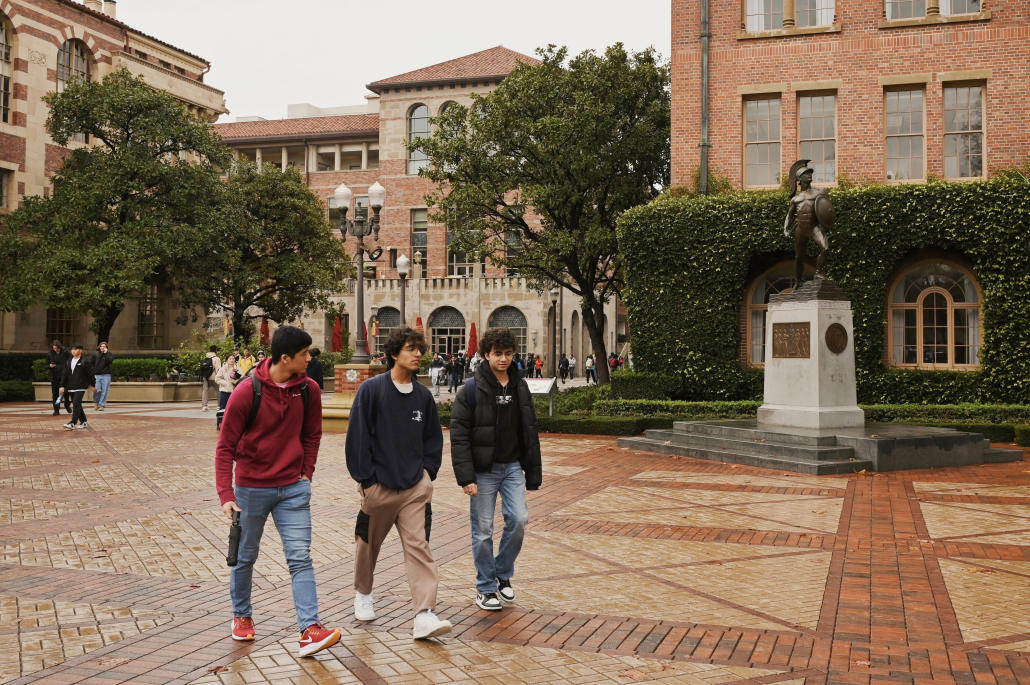Blizzards, floods and hail: Erratic winter storm tests Los Angeles, USC

Over the last several weeks, Los Angeles residents have faced atypical weather conditions, as rainstorms hit the city, bringing with them hail and snow. L.A. will face additional rain on Friday and next week, the Weather Channel projects.
In the course of two weeks, L.A. has faced rain, hail and warnings of blizzards and floods. The severe weather event caused mudslides, rockslides, flooded areas and icy roads, the California Department of Transportation wrote in a March 3 statement to the Daily Trojan.
“The past few months have certainly caused more damage than is typical by this time of year,” the statement read. “The [L.A.] area saw a number of closures and delays on our roadways, as well as damage to some infrastructure.
Michael Qi, a freshman majoring in electrical and computer engineering, said he was annoyed at the unexpected weather and felt unprepared for the quick change.
“I grew up here, so I’m not really prepared for the rain,” Qi said. “It’s very inconvenient for me.”
For Cheska Pangilinan, a junior majoring in environmental studies, recent climate fluctuations have caused deeper concerns for the future.
“[This is] definitely not a one-off event,” Pangilinan said. “This weird weather is going to become more frequent … as the climate crisis worsens.”
Infrastructure is an area that poses a unique challenge for USC. University Park Campus has already experienced the effects of unexpected rain: the Music Complex building, for one, was temporarily closed following flooding.
A spokesperson for the University told the Daily Trojan that the recent storms had no major impacts on the University, including no power outages or infrastructural damages.

The weather caused flooding of some streets and highways across L.A. Colin Sweeney, the director of public information at the Los Angeles Department of Transportation, said drivers should not enter flooded streets or flooded areas. It takes only about six inches of water — especially if it’s flowing — to carry a car away, Sweeney said.
In its statement, Caltrans wrote that the agency was prepared for the storm’s impact, and maintenance and repair crews have quickly fixed most of the damage it caused.
“We know that closures and delays can be frustrating,” the statement read. “But we are asking the public for patience as our crews work tirelessly, sometimes in treacherous weather conditions, to restore our roadways.”
Some elements of L.A.’s infrastructure have functioned well amid strenuous weather conditions, said Adam Rose, director emeritus of the USC Center for Risk and Economic Analysis of Threats and Emergencies. The cement-paved L.A. River, which often appears to only flow at a trickle, is meant to capture and carry away the water from heavy rain to avoid flooding, Rose said.
The recent storms have shown, though, that the city’s stormwater drainage systems are inadequate. Stormwater drain systems in L.A. were built to collect a certain amount of water, but the recent heavy rain has surpassed these levels and has led to flooding, said Rose, a research professor at the Sol Price School of Public Policy.
Drainage systems are just one aspect of California’s infrastructure that must be improved, Rose said. California received a C- in a 2019 infrastructure report card by the American Society of Civil Engineers.
“Change in climate conditions has produced heavier rains, stronger storms and higher winds. This is the new normal,” the ASCE report read. “Old bridges were not designed for these loads.”
The severe weather will also have long-term impacts throughout L.A. County. In wildfire prone areas, the strong rain can cause a more robust growth of grasses and greenery, said Jorge Anaya, an emergency management coordinator for L.A. County’s Office of Emergency Management.
The increased vegetation can become a problem when the wildfire season rolls around, making it especially important to monitor wildfire areas during the fire season, Anaya said. It’s important, he said, that L.A. residents manage the plants near their homes by maintaining a defensible space to protect property against wildfire.
Rose said the United States has historically not been effective at maintaining its infrastructure.
“When budgets are tight, maintenance is one of the things that you give up first because it’s not broken yet,” Rose said. “Then you repair what actually breaks.”
While the recently passed Inflation Reduction Act — which includes billions of dollars to improve infrastructure across the nation — would be a significant help, Rose said, there is still more that needs to be done to maintain and upgrade infrastructure systems in the U.S.
“[The Inflation Reduction Act] is really just a start,” Rose said. “We need to do better than that.”
Correction: A previous version of this story read that “A spokesperson for the University declined the Daily Trojan’s request for comment on the recent storms citing no major impacts on the University, including no power outages or infrastructural damages.” This language incorrectly conveyed a lack of cooperation from the University; more aptly, the storms’ lack of impact was confirmed by the spokesperson, but simply did not warrant an official statement. The Daily Trojan regrets this error.

